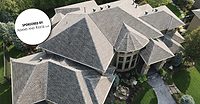Roof Coatings 2024
Confidence in Coatings
Economic conditions continue to provide roofing contractors with opportunities in coatings.

Roof coatings have been an effective solution for roofing contractors in the field for more than 50 years, but technological advances and improved accessibility in the marketplace accelerated particularly over the past decade.
And that’s not likely to slow down. Recent projections from Future Market Insights shows the overall roofing material market growing by about 4.6% over the next decade to surpass $231 billion. Coatings are expected to be a big part of that for several key reasons.
Construction projects in the United States and Canada are on the rise, and the rest of the world appears to be following suit. As federal and local governments continue to emphasize improvements to industrial, energy and affordable housing infrastructure, construction rates should increase. Some experts predict the average annual rate of growth for construction in North America to be around 3.5 percent from 2025-28.
As the rest of the world become exposed to these changes, and likely adopts more stringent building codes modeled after the U.S., the demand for cost-effective roofing solutions that also address energy efficiency will also likely grow. Enter roof coatings, which have a long-standing reputation for extending roof life when complete tear-offs aren’t immediately necessary.
Coatings that reflect harmful UV rays in sunsoaked regions of North America are increasing energy efficiency and decreasing electricity bills.
They also help the environment by delaying or even preventing rooftop waste from reaching landfills by extending lifecycles. The Roof Coatings Manufacturers Association estimates 2.5 billion square feet of roofs are replaced or re-coated every year, and that roofing materials are the third-largest contributor to landfills. Coatings provide an ideal, cost-effective solution, and more roofing contractors appear to be listening to demand from business owners.
Roofer Response
Roofers that responded to RC’s annual State of the Industry survey indicated the coatings sales market remains strong. More than half (53%) are involved with coatings, estimating that service accounts for roughly 6% of annual revenue. That is a bit down from last year’s survey, where involvement spiked at 66% and 8% of revenue. However, still strong enough to rank among the top five most popular product categories, behind only single-ply, asphalt shingles and metal.
Roughly half of those contractors also said sales grew last year, and that number swelled further when asked to project sales for 2024 and 2025, the data showed.
The positive inertia in sales is happening in both residential and commercial markets. About 45% of contractors said their coatings sales improved from 2023, and 52% expected that increase to continue through this year. Commercial sales increases were more robust, estimated at 54% and projected to top 60% by year’s end.
Commercial roofers also reported installing more polymer-synthetic roofs (41%) than in previous years, responding to customer demand.
When Coatings Count
Entry into the roof coatings market isn’t that difficult for roofing contractors, but it isn’t without its challenges. Training, equipment and workers willing to buy-in are essential. So to is the patience and vision needed to endure the usual growing pains of adding a new service offering to the business model. Application methods are getting safer and more time efficient for roofing contractors, and their use may be more situational depending on the project type and any region-specific requirements for use. However, roofing contractors must account for the following to make roof coatings successful:
- The substrate and surface need to be clear of all dust, dirt and debris or the coating can blister.
- Structural vulnerabilities cannot be cured by coatings. Roofers need to carefully evaluate the membrane, substrate and other system components to identify and repair tears or peels before starting.
- The surface, insulation, roof deck all need to be completely dry for a roof coating to work effectively.
Without meeting the above criteria, a roof coating may lose its effectiveness earlier than expected. Regardless of the installation type or scope of the project, following the manufacturer’s installation guidelines and specifications is the place to start, even when recoating an existing roof coat. Working together with your product partners will help ensure the right system is in place for the right job to deliver the right result.
Looking for a reprint of this article?
From high-res PDFs to custom plaques, order your copy today!






